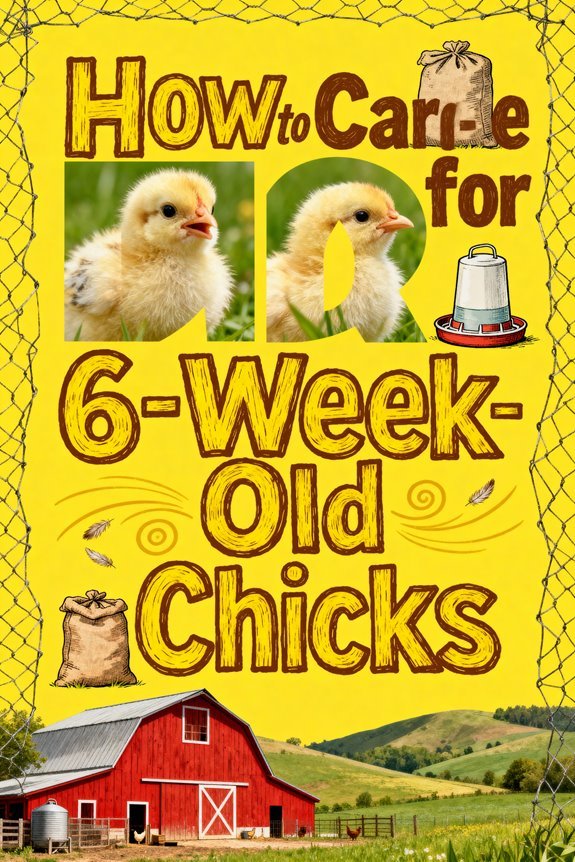What Do Chickens Love to Eat: A Guide to Favorite Foods
Your chickens need a scientifically balanced diet combining commercial feed (16-22% protein) with carefully selected treats. You’ll want to provide layer feed for adult hens, with higher protein starter feeds for chicks under 8 weeks. They’ll thrive on protein-rich treats like mealworms and nutrient-dense vegetables, while maintaining proper calcium levels (2.75-4.12%) for strong eggs. Understanding the complete nutritional requirements guarantees peak health and productivity for your flock.
Essential Nutrients Your Chickens Need Daily
Chickens rely on a complex balance of essential nutrients to thrive and maintain ideal health. You’ll need to guarantee your birds receive adequate protein (containing critical amino acids like lysine and methionine), carbohydrates for energy, and fats that help absorb essential vitamin sources A, D, E, and K. The nutrient balance must include metabolizable energy of 11.3-12.6 MJ/kg, depending on growth stage. For optimal health, chickens should consume twice as much water as feed.
Your flock requires specific daily mineral intake, with calcium comprising 2.75-4.12% of their diet and available phosphorus at 0.21-0.31%. For laying hens, provide large particle calcium like oyster shells or limestone grit separately from feed, allowing birds to self-regulate their intake for optimal eggshell quality and bone health. Don’t overlook water-soluble B vitamins, which support energy metabolism and nerve function. Monitor for deficiency symptoms like curled-toe paralysis (riboflavin deficiency) or neurological issues (thiamine deficiency). Supplementing with protein-rich treats like mealworms can improve egg quality when fed in moderation alongside their complete diet. Proper nutrient levels prevent metabolic diseases while supporting egg production and overall health.
Best Commercial Feed Options for Happy Hens
When selecting commercial feed options for your laying hens, you’ll need to choose between pelleted, crumble, and mash formulations, each offering distinct advantages for nutrient delivery and feed efficiency. While whole grain feed provides the most natural diet for homestead flocks, pellet feed benefits include uniform nutrient distribution, reduced waste, and easier storage, though they’re more processed than other options. You’ll find crumble feed advantages particularly useful when changing young birds, as these broken-down pellets combine digestibility with complete nutrition.
For best results, match your feed type to your hens’ life stage: starter feeds (18-20% protein) for chicks under 6 weeks, grower feeds (16% protein) for pullets 6-18 weeks, and layer feeds (16-18% protein with added calcium) for mature laying hens. Quality options like Barastoc Champion Layer provide the high-protein layer feed that should form the largest part of your hens’ diet. When evaluating commercial brands, consider options from Purina, Kalmbach, or Nutrena that offer formulations tailored to different breed sizes and dietary requirements. This guarantees proper nutrition throughout their development while supporting consistent egg production.
Natural Treats That Make Chickens Go Wild
Although commercial feed forms the foundation of a balanced chicken diet, natural treats provide crucial enrichment while delivering diverse micronutrients and behavioral stimulation. You’ll find your chickens enthusiastically engaging in natural foraging when offered protein-rich options like mealworms and crickets, which support feather development and egg production. Fresh fruits, especially watermelon and berries, deliver hydration and antioxidants, while vegetables such as broccoli and leafy greens contribute essential fiber and minerals. Raspberries are safe for chickens when offered fresh and in moderation, providing beneficial vitamins, minerals, and fiber that support overall flock health. Cabbage both raw and cooked serves as an excellent nutritious treat, offering vitamins A, C, K, and essential minerals while providing entertainment when hung in their run. To maximize nutritional benefits, maintain treat moderation at 10% of their total diet. Consider creating engaging feeding stations with herb garlands or hanging vegetables to stimulate natural pecking behaviors. Snack piñatas with corn can provide hours of entertainment while encouraging natural foraging instincts. Rotate seasonal offerings like pumpkin seeds and sprouted grains to guarantee sustained interest while supporting optimal health through varied nutrient profiles.
Feeding Guidelines Throughout Different Life Stages
Beyond natural treats, understanding age-specific nutritional requirements forms the cornerstone of proper chicken care. You’ll need to follow precise feeding schedules that evolve with your birds’ growth stages. Start with high-protein starter feed (18-22%) for chicks up to 8 weeks, then shift to grower feed (16-18%) until week 16. During the developer phase, you’ll reduce protein to 14-16% as your pullets approach laying age. Once they begin laying around week 18, switch to layer feed with 16-18% protein and increased calcium (3-4%). Maintain nutrient balance by adjusting daily portions from 1 ounce for chicks to 4 ounces for adult layers. Remember, consistent feeding practices and proper nutrient ratios are essential for peak health and productivity. Offering free-choice oyster shells alongside regular feed provides laying hens with crucial calcium supplementation for strong eggshells.
Common Dietary Mistakes to Avoid
Despite widespread access to feeding guidelines, chicken owners frequently make costly dietary mistakes that compromise flock health and productivity. You’ll need to avoid overfeeding issues by carefully measuring portions based on your birds’ age, breed, and activity level. Don’t allow unlimited access to feed, which leads to obesity and reduced egg production. Avoid giving your flock too many kitchen scraps and treats, as this can significantly dilute the essential nutrients they need from their complete layer feed.
Store feed properly in sealed containers to prevent moisture and mold growth. You’ll want to clean feeders regularly to avoid bacterial contamination that can sicken your flock. Don’t fall into the trap of using unbalanced grain mixes or diluting commercial feed with cheaper alternatives – this creates nutritional deficiencies. While organic and natural feeding methods can be beneficial, they shouldn’t replace properly formulated commercial feeds designed to meet your hens’ specific nutritional requirements.
Safe Kitchen Scraps and Garden Goodies
When incorporating kitchen scraps into your chickens’ diet, carefully select nutrient-rich options while adhering to the 10% dietary supplement rule. You’ll find that vegetables like carrots, broccoli, cauliflower, and corn offer safe, nutritious choices, while cooked potatoes and sweet potatoes provide beneficial starches. This sustainable practice can help cut feed costs by up to 20%.
Your garden wastes, including leafy greens such as bok choy, silverbeet, and lettuce, can be diverted from compost to supplement your flock’s nutrition. For protein enrichment, you can offer small amounts of cooked meat scraps or eggs. Remember to provide grit for proper digestion and remove uneaten scraps promptly to prevent pest attraction.
Always avoid toxic items like raw potato skins, avocado peels, and moldy bread. Feed kitchen scraps only to mature chickens, using designated containers for easy cleanup and monitoring.


